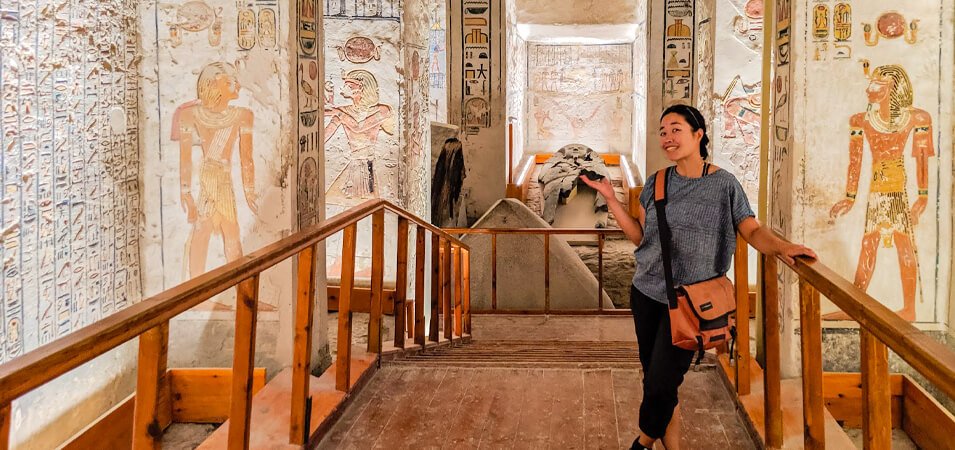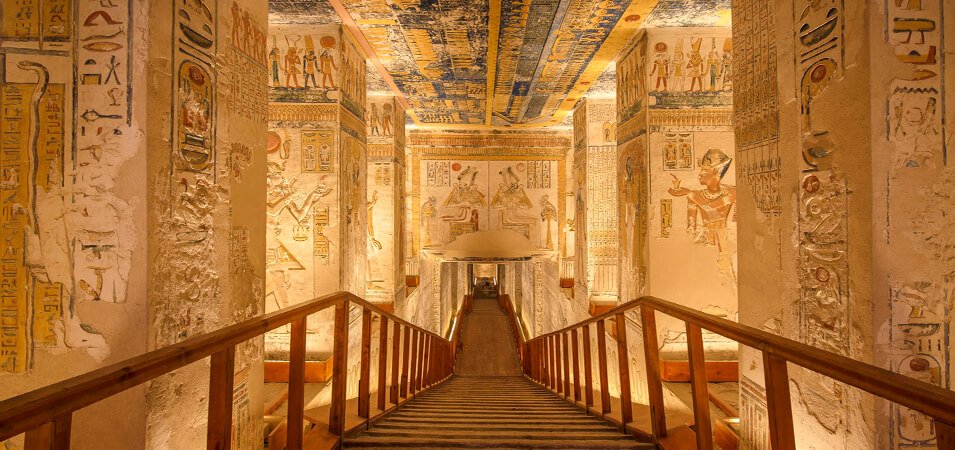Deep within Egypt, carved into the golden cliffs overlooking the Nile River, lies the Valley of the Kings. For centuries, this hidden cemetery was the final resting place for Egypt’s most powerful rulers – the Pharaohs. Vast underground chambers exist here, adorned with colorful murals depicting scenes from the afterlife and intricate hieroglyphics whispering tales of forgotten rituals. These elaborately designed tombs were not simply burial sites; they were gateways to eternity, meticulously crafted to ensure the Pharaoh’s safe passage into the next life.
This blog post is your invitation to journey into this legendary valley. Whether you’re a seasoned traveler, a history buff, or a curious student, the Valley of the Kings offers a glimpse into a bygone era, filled with fascinating details about ancient Egyptian beliefs, artistic mastery, and the enduring allure of Pharaohs.

A Journey Through Time
- A City of the Dead: Deep within the golden cliffs overlooking the Nile River lies the Valley of the Kings, an ancient necropolis that served as the final resting place for Egypt’s Pharaohs during the New Kingdom period (1550-1069 BC).
- Home to Pharaohs: This valley transformed into a massive cemetery, housing the bodies of some of Egypt’s most prominent Pharaohs. Among them lies Tutankhamun, more popularly known as King Tut, and Ramses II, who reigned for over 60 years.
- Religious Significance: The Valley’s location on the west bank of the Nile, associated with the setting sun and the underworld, held religious significance for the ancient Egyptians who believed in the afterlife.
- Protection from Grave Robbers: The remote and dry nature of the valley offered a natural defense against grave robbers, a growing concern during this period.
- Massive Undertaking: Constructing these elaborate underground tombs was a massive feat for the ancient Egyptians. Workers meticulously carved vast chambers deep within the cliffs, facing challenges like limited lighting and ventilation.
- Canvases for the Afterlife: The walls of these tombs were transformed into canvases, adorned with vibrant murals depicting scenes from the Pharaoh’s journey to the afterlife. Hieroglyphic texts inscribed on the walls served as guides and offered prayers for the Pharaoh’s safe passage.
- Treasures for the Next World: Artifacts like golden masks, statues, and funerary furniture were placed within the tombs, providing the Pharaoh with everything they might need in the afterlife.
Descending into Eternity: Exploring the Tombs of the Valley of the Kings
Delving deep beneath the Egyptian desert sands, the Valley of the Kings offers a glimpse into the past through its elaborate tombs. These meticulously carved structures were designed to serve as eternal homes for Pharaohs, acting as portals to the afterlife.
Imagine descending into a cool, dark passageway that leads into a labyrinthine network of corridors and chambers. The walls themselves are a marvel, Carved from limestone rock, they are adorned with intricate hieroglyphs and colorful paintings that tell a story. These hieroglyphs are not just fancy decorations; they are a written language that unlocks the secrets of the afterlife beliefs and rituals of the ancient Egyptians.
The artwork adorning the tombs is a visual representation of the Pharaoh’s journey to the next life. Scenes depict the Pharaoh being presented to Osiris, the god of the underworld, and undergoing various trials to ensure their safe passage. These vibrant murals offer invaluable insights into the religious beliefs of the time.
Each tomb is designed with specific chambers serving different purposes. An entrance corridor might lead to a grand hall, possibly adorned with statues of the Pharaoh. Deeper chambers might house the Pharaoh’s sarcophagus, a decorated stone coffin where their mummy was laid to rest.
Treasure chambers would contain an array of precious objects meant to accompany the Pharaoh on their journey to the afterlife. These objects could include jewelry, gold statues, shabti figures (small statues depicting servants meant to perform tasks for the Pharaoh in the afterlife), and furniture believed to be needed in the next world.
The Valley of the Kings is a UNESCO World Heritage Site, and a great deal of effort goes into preserving these remarkable tombs. Environmental factors and tourist activity can damage delicate artwork and structures. Archaeologists and conservators work tirelessly to document, restore, and protect these irreplaceable treasures.
Some of the Pharaohs buried in the Valley of the Kings include:
- Tutankhamun (King Tut)
- Ramses II
- Hatshepsut
- Thutmose III
- Seti I
This is not an exhaustive list, but it gives you a sense of the variety of Pharaohs interred in the Valley of the Kings.
Exploring the Valley of the Kings is a journey through time, offering a window into the lives, beliefs, and artistic mastery of the ancient Egyptians. The meticulously designed tombs continue to amaze and teach us about this fascinating civilization.
The Discovery of King Tut’s Tomb
Perhaps the most famous resident of the Valley of the Kings is Tutankhamun, more popularly known as King Tut. His tomb’s discovery in 1922 by British archaeologist Howard Carter sparked a worldwide frenzy. For years, Carter had meticulously searched the valley, facing funding challenges and skepticism from the archaeological community. Finally, after years of tireless work, his determination paid off. The entrance to Tutankhamun’s tomb, hidden beneath debris for centuries, was unearthed.
The excavation of the tomb was a slow and meticulous process, taking nearly a decade to complete all the chambers. As each room was revealed, the world watched in awe. Treasures beyond imagination were found within, including Tutankhamun’s golden funerary mask , a breathtaking depiction of the young Pharaoh. The tomb also housed exquisite jewelry, golden furniture, statues, chariots, and everyday objects meant to accompany the king on his journey to the afterlife.

The discovery of Tut’s nearly intact tomb, filled with such riches, captured the public imagination. Newspapers across the globe reported on the excavation’s progress, and the world marveled at the craftsmanship and artistry of these ancient objects. However, the discovery also sparked myths and legends. Stories of a “Curse of the Pharaohs” emerged, fueled by the untimely deaths of some individuals involved in the excavation. These dramatic tales, though captivating, have been debunked by archaeologists.
The discovery of Tutankhamun’s tomb remains one of the most significant archaeological finds in history. It provided a window into the life and death rituals of an ancient Egyptian Pharaoh, offering invaluable knowledge about their culture and beliefs.
Visiting the Valley of the Kings
The Valley of the Kings beckons travelers with its promise of unveiling ancient secrets. But before you embark on your Egyptian adventure, consider these helpful tips to ensure a smooth and enriching visit.
- Conquering the Climate: The Valley of the Kings basks under the Egyptian sun year-round. Opt for the cooler months, ideally between October and April, to avoid scorching temperatures.
- Tickets to the Past: Tickets can be purchased at the visitor center upon arrival. There’s a general entrance fee that allows access to three tombs, excluding a few like Tutankhamun’s. For an extra fee, you can purchase separate tickets to visit these special tombs. Consider purchasing your tickets online beforehand, especially during peak season, to avoid long queues.
- Packing for Pharaohs: Dress comfortably in loose, lightweight, and breathable clothing that covers your shoulders and knees. A hat, sunglasses, and sunscreen are essential for sun protection. Comfortable shoes are a must, as you’ll be doing some walking on uneven terrain.
- Beyond the Valley: Luxor, on the east bank of the Nile, is a treasure trove of ancient sites. Explore the majestic Karnak Temple complex or Luxor Temple, both architectural marvels. Consider guided tours that provide historical context and insights into these fascinating places.
Remember, respect the sanctity of this archaeological site and be mindful of preserving its wonders for future generations.
Conclusion
The Valley of the Kings stands as a testament to the architectural brilliance and unwavering faith of the ancient Egyptians. For centuries, it served as the final resting place for Pharaohs, offering a glimpse into their beliefs about the afterlife. The meticulously designed tombs, adorned with vibrant murals and hieroglyphic texts, whisper tales of ancient rituals and journeys into the next world.
Today, the Valley of the Kings is a UNESCO World Heritage Site, a protected treasure trove for all humanity. Consider embarking on your adventure to explore these remarkable tombs. As you delve into the Valley’s depths, prepare to be amazed by the artistic mastery, historical significance, and enduring mysteries that linger within its walls.
FAQs
1. What is the Valley of the Kings?
The Valley of the Kings is an ancient necropolis in Egypt, located on the west bank of the Nile River. It served as the final resting place for many Pharaohs and powerful nobles during the New Kingdom period (1550-1069 BC).
2. Why was the Valley of the Kings chosen as a burial site?
The location was chosen due to its religious significance, as the west bank of the Nile was associated with the setting sun and the underworld. The valley’s remote and hidden nature also offered protection from grave robbers.
3. What can I expect to see inside the tombs?
Inside the tombs, you’ll find intricately carved walls adorned with colorful murals and hieroglyphs. These depict scenes from the Pharaoh’s journey to the afterlife and contain prayers and spells intended to guide and protect them in the next world.
4. Who are some of the famous Pharaohs buried in the Valley of the Kings?
Some notable Pharaohs buried here include Tutankhamun (King Tut), Ramses II, Hatshepsut, Thutmose III, and Seti I.
5. What treasures were placed in the tombs?
The tombs were filled with valuable items meant to accompany the Pharaohs in the afterlife, such as golden masks, statues, jewelry, shabti figures, and funerary furniture.
6. How can I visit the Valley of the Kings?
Visitors can access the Valley of the Kings by purchasing tickets at the visitor center. A general ticket allows entry to three tombs, with additional fees required to visit special tombs like that of Tutankhamun.
Read other Related Articles:
